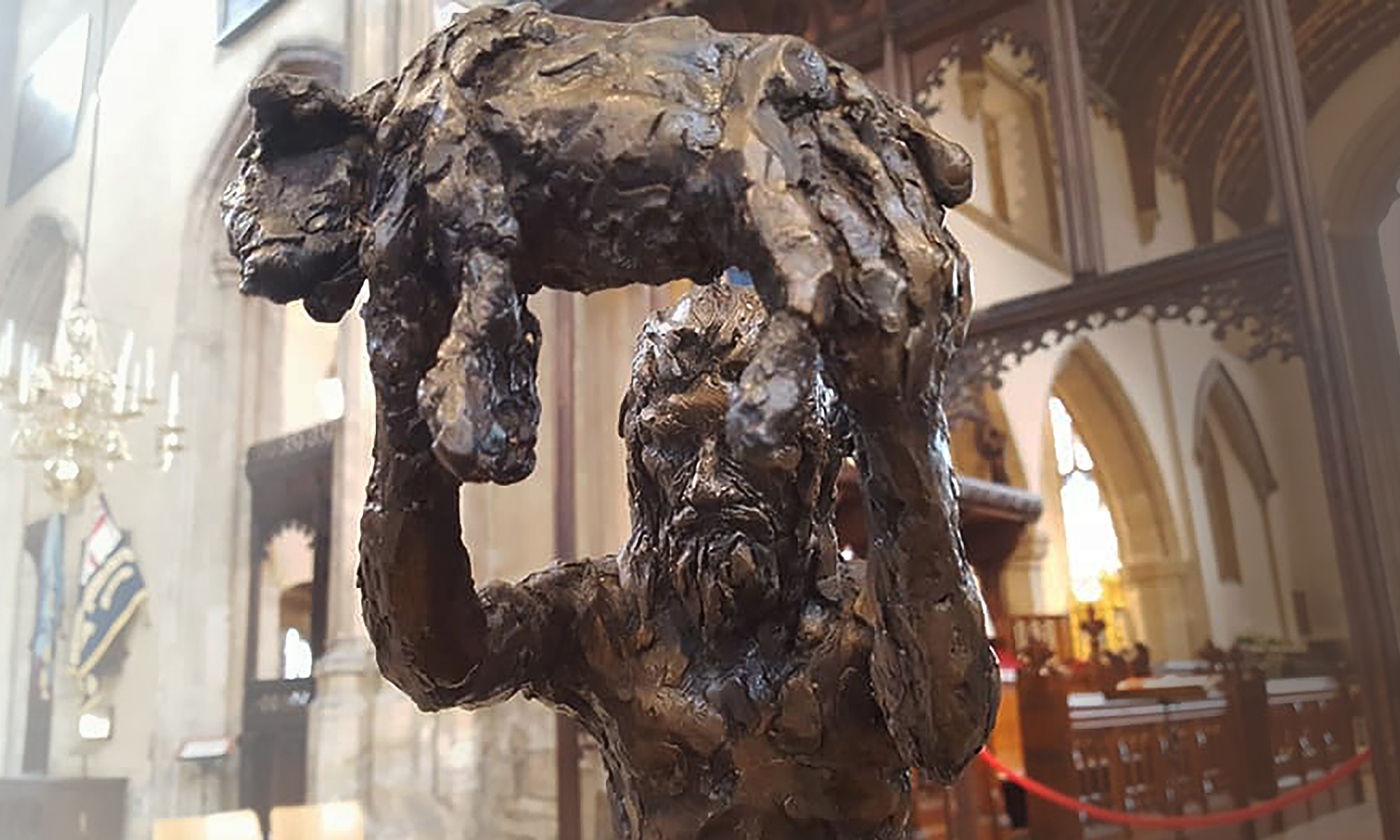Trifold Leaflet
Rodney Munday banner
Statement of Need
Words from Rodney Munday
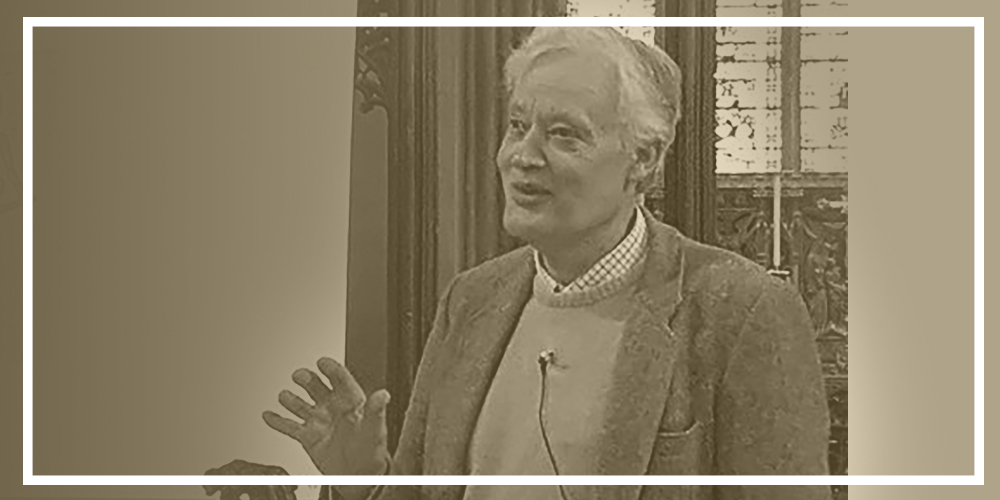 I am proud to have been chosen to take this project forward. My original aim was
1) To make a statement about the relevance that St. John the Baptist and the Virgin Mary have within the context of contemporary Christianity, in order to affirm the understanding that the Parish Church stands at the spiritual heart of the community.
2) To produce contemporary works that are visually interesting, but do not jar with the ancient structure of the church. The sculpture should appear to be a natural part of that structure, to which they would be both subservient and complementary.
My original idea for St John, changed following my visits to Cirencester Originally, I proposed that I would depict the Baptist as a harsh figure of a man; the last of the Old Testament prophets who brought a message of destruction as the consequence of man's sin; a representation of a contrast between the Old and New Testaments, between which John forms a bridge. I envisaged him holding a cross which would prefigure the crucifixion, and link him to the sculpture of the Virgin and Child.
With the passage of time, I felt that although the image could be an impressive and relevant one, I was finding it difficult to relate personally to this figure of John, and I expressed my difficulty to Canon Morris. In discussion, he told me that he saw that John was not important to himself, but saw himself as an intermediary revealing a future. Subsequently members of the congregation pointed out the John Baptist window, depicting the Baptist holding a lamb, the only image I have seen of him doing so as a man, and it was suggested that the lamb might have been included because of the importance of the wool trade to the town.
Following these conversations, I rethought my representation, and John now holds out a lamb – the Lamb of God – over the town and over the people into which he is looking. For me, this is a more relevant link to the New Testament, and I am happy that it also refers back to Cirencester's past, and its present within a farmed countryside. I believe that linking the religious and lay contexts of a location is important in bringing the whole community together; and I am minded of the Eucharist I attended on one of my visits to Cirencester, when the door of the church was left wide open, and I felt that it symbolised the way the church invited and embraced the town.
It seems to me that representations of Mary also inevitably pose some problems within the Protestant tradition. Her role as a mediator between man and God, once so important within the Roman Catholic tradition, raises difficulties. At the same time, a simple image of a mother and child can easily become one that might be any mother with any child, or at worst be sentimentalised.
In order to address these problems, I envisaged the Virgin holding a standing Christ-child by both hands, as he leans out of the niche in a position typical of a child's curiosity and fearlessness, whilst at the same time being suggestive of his crucifixion. As Mary holds him, the sculpture is both Madonna and Child, and Pieta, looking beyond Christ's childhood to a future where Mary bears his body after the descent from the cross. The sculpture would have the timeless relevance of depicting the important, if difficult fact, that the way of Christ is the way of the cross.
I look forward to further contact with Cirencester and its people and hope that my ideas will develop through a rich process of engagement.
I am proud to have been chosen to take this project forward. My original aim was
1) To make a statement about the relevance that St. John the Baptist and the Virgin Mary have within the context of contemporary Christianity, in order to affirm the understanding that the Parish Church stands at the spiritual heart of the community.
2) To produce contemporary works that are visually interesting, but do not jar with the ancient structure of the church. The sculpture should appear to be a natural part of that structure, to which they would be both subservient and complementary.
My original idea for St John, changed following my visits to Cirencester Originally, I proposed that I would depict the Baptist as a harsh figure of a man; the last of the Old Testament prophets who brought a message of destruction as the consequence of man's sin; a representation of a contrast between the Old and New Testaments, between which John forms a bridge. I envisaged him holding a cross which would prefigure the crucifixion, and link him to the sculpture of the Virgin and Child.
With the passage of time, I felt that although the image could be an impressive and relevant one, I was finding it difficult to relate personally to this figure of John, and I expressed my difficulty to Canon Morris. In discussion, he told me that he saw that John was not important to himself, but saw himself as an intermediary revealing a future. Subsequently members of the congregation pointed out the John Baptist window, depicting the Baptist holding a lamb, the only image I have seen of him doing so as a man, and it was suggested that the lamb might have been included because of the importance of the wool trade to the town.
Following these conversations, I rethought my representation, and John now holds out a lamb – the Lamb of God – over the town and over the people into which he is looking. For me, this is a more relevant link to the New Testament, and I am happy that it also refers back to Cirencester's past, and its present within a farmed countryside. I believe that linking the religious and lay contexts of a location is important in bringing the whole community together; and I am minded of the Eucharist I attended on one of my visits to Cirencester, when the door of the church was left wide open, and I felt that it symbolised the way the church invited and embraced the town.
It seems to me that representations of Mary also inevitably pose some problems within the Protestant tradition. Her role as a mediator between man and God, once so important within the Roman Catholic tradition, raises difficulties. At the same time, a simple image of a mother and child can easily become one that might be any mother with any child, or at worst be sentimentalised.
In order to address these problems, I envisaged the Virgin holding a standing Christ-child by both hands, as he leans out of the niche in a position typical of a child's curiosity and fearlessness, whilst at the same time being suggestive of his crucifixion. As Mary holds him, the sculpture is both Madonna and Child, and Pieta, looking beyond Christ's childhood to a future where Mary bears his body after the descent from the cross. The sculpture would have the timeless relevance of depicting the important, if difficult fact, that the way of Christ is the way of the cross.
I look forward to further contact with Cirencester and its people and hope that my ideas will develop through a rich process of engagement.
Rodney Munday is regularly updating his blog which you can view and send your thoughts & comments by clicking here.
Press Release February 2020
Except that he may not be black. For the past year a small group has been working on restoring the statues to the northwest and south west niches of the Parish Church tower. The statues were taken down in 1963 (see photo of the Wilts and Glos Article) with a promise that at sometime they would be put back.
Following the guidelines for commissioning church art the project group have held a national competition to help design statues for the niches. A call from Expressions of Interest attracted national attention and from the responses five artists were chosen to provide initial designs. All the artists had a national reputation and had been involved in major projects. A display over the Heritage Open Weekend allowed us to see the range of styles under consideration.
All the artists spent some time in Cirencester visiting the church including attendance at services , trips up the tower and speaking to local people. The five designs were considered by a panel of experts in December.
The criteria for the project asked that the design
• Showed an understanding that the Parish Church stands at the spiritual heart of the community
• Is sympathetic to the surrounding environs, enhancing the fabric of the church now and for future generations
• That the design was sympathetic to the fabric of the building and to the local environs
• Is visually engaging, exciting and of high quality in terms of both creative design and proposed material output)
The artist chosen was Rodney Munday. His proposal is to create the two statues in bronze. He says he had originally intended to present St John as a rugged figure bearing a staff, but discussions with the vicar and members of the congregation changed his thinking. His statue of St John the Baptist now has the saint holding out a lamb. His statue of the Virgin Mary shows Mary holding a child who is inquisitively looking down into the Market Place. (Sketch of virgin).
The designs are at an initial stage and Rodney will be visiting Cirencester regularly over the coming months to engage with the church congregation and the wider community to refine his ideas, so that the finished statues truly reflect the aspirations of the church.
Rev Graham Morris, who was part of the selection group said “I am really thrilled that we are having the statues back. It is a project that is dear to the heart of many people. The designs reflect both the theological and ecclesiastical aspirations that I had, plus the wider sense of community engagement. I am confident that we will have new works of art that really do justice to our church and congregation”.
The chosen design was approved by the PCC in December and has been submitted to the Diocesan Advisory Board for approval. Hopefully in February there will be the go-ahead to take this project to the next stage. Next month in the Parish Magazine we will feature Rodney Munday and his work, but you can find out more about his work by looking at his website. An example of a national project he completed at Plymouth Minster can be found on “Art at the Minster” (Plymouth). This shows how he worked with the congregation on St Andrew the Fisher.
Talk By Rodney Munday, Artist and Sculpture
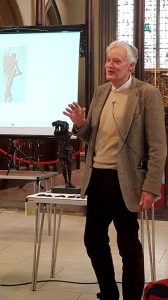
Removal of Statues in 1963
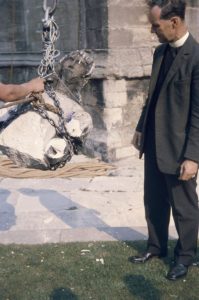
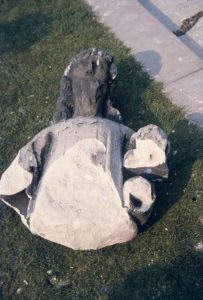
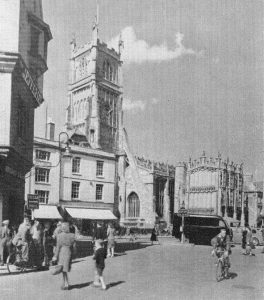 View of the Market Place circa 1945 - 54 with the south-west niche figure highlighted; note long shadows from the foreground building on the corner of Castle Street which is indicative of late afternoon and hence a high level of natural lighting striking the niche/ figure (image reproduced from ‘The Story of Cirencester Parish Church by Archdeacon J. S. Sinclair, former Vicar of Cirencester 1898 - 1909; revised by W. I. Croome, Chairman of Gloucester Diocesan Advisory Committee in 1945’ (© The British Publishing Company Limited)
View of the Market Place circa 1945 - 54 with the south-west niche figure highlighted; note long shadows from the foreground building on the corner of Castle Street which is indicative of late afternoon and hence a high level of natural lighting striking the niche/ figure (image reproduced from ‘The Story of Cirencester Parish Church by Archdeacon J. S. Sinclair, former Vicar of Cirencester 1898 - 1909; revised by W. I. Croome, Chairman of Gloucester Diocesan Advisory Committee in 1945’ (© The British Publishing Company Limited) One Cold & Windy Morning
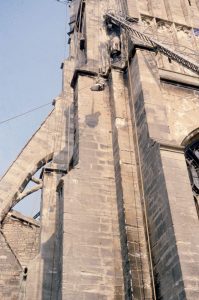
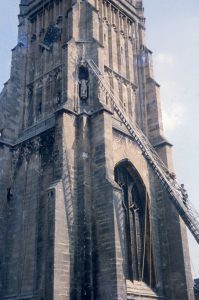 It was November sometime in the 1960's, the weather was chilly and the winds blew.
A tower inspection was needed at St John Baptist Church, Cirencester.
"Cherry-pickers" were often used by specialists to inspect ancient stonework. The hydraulic platform lifted the architect to take a closer look. This is an inspection that the church had to carry out at intervals. A close-up look was often necessary as well as stonework checks using regular over-the-counter binoculars.
It was November sometime in the 1960's, the weather was chilly and the winds blew.
A tower inspection was needed at St John Baptist Church, Cirencester.
"Cherry-pickers" were often used by specialists to inspect ancient stonework. The hydraulic platform lifted the architect to take a closer look. This is an inspection that the church had to carry out at intervals. A close-up look was often necessary as well as stonework checks using regular over-the-counter binoculars.
As you can imagine, it was very wobbly up there!#ProjectBlackJack #Cirencester #History
